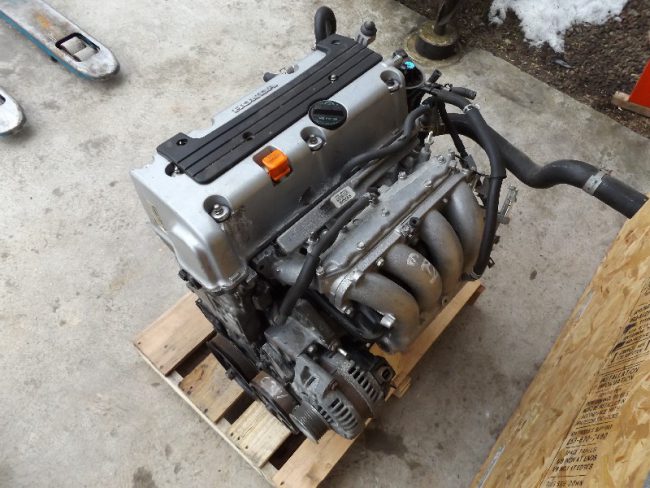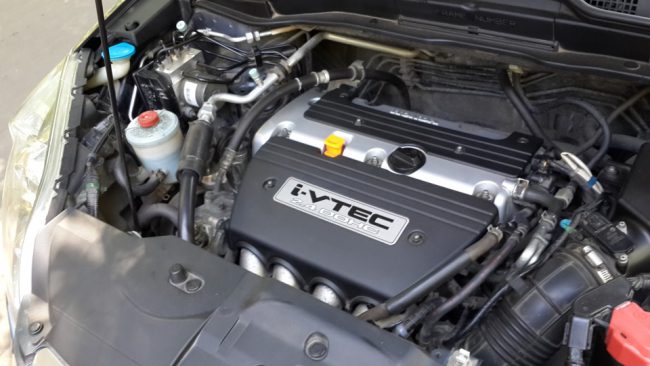
Honda K24Z1, K24Z2, K24Z3, K24Z4, K24Z7 engines
Content
The K-series motors of the Japanese concern are controversial - on the one hand, they are technologically advanced and efficient units that boast outstanding technical characteristics, on the other hand, these engines have problems that are analyzed in detail on various automotive forums and websites.
For example, compared to the B-series engines, the K-series ICEs proved to be problematic. Despite this, they are installed on the best models from Honda due to their high technical characteristics.

Parameters and vehicles with engines K24Z1, K24Z2, K24Z3, K24Z4, K24Z7
The characteristics of the Honda K24Z1 engines correspond to the table:
| Year of construction | 2002 - our time |
|---|---|
| Cylinder block | Aluminum |
| Supply system | Injection |
| A type | Inline |
| Number of cylinders | 4 |
| Number of valves per cylinder | 4 pcs, total 16 pcs |
| Piston stroke | 99 mm |
| Compression ratio | 9.7 - 10.5 (depending on version) |
| Exact volume | 2.354 l |
| Power | 166-180 hp at 5800 rpm (depending on version) |
| Torque | 218 Nm at 4200 rpm (depending on version) |
| Fuel | Gasoline AI-95 |
| Fuel consumption | 11.9 l/100 km city, 7 l/100 highway |
| Oil viscosity | 0W-20, 5W-20, 5W-30 |
| Engine oil volume | 4.2 liters |
| Possible oil consumption | Up to 1 liter per 1000 km |
| Replacement via | 10000 km, better - after 5000 km. |
| Motor life | 300+ thousand km. |
These motors were installed on the following cars:
- K24Z1 - Honda CR-V 3 generations - from 2007 to 2012.
- K24Z2 - Honda Accord 8th generation - 2008-2011.
- K24Z3 – Honda Accord 8 Generations – 2008-2013
- K24Z4 - Honda CR-V 3 generations, including restyling - 2010-2012.
- K24Z7 - Honda CR-V 4 generations, Civic Si and Acura ILX - 2015 - our time.
The K24 series includes modern technological engines that have received various modifications and versions. Motors K24Z - one of the series, which included 7 engines with minor design changes.

Modifications
The 2.4-liter Honda K-series engines replaced the F23 ICE. They are based on 2-liter K20 engines. It's just that the K24 uses crankshafts with an extended piston stroke (99 mm versus 86 mm), the pistons themselves have a larger diameter, a different cylinder block, new connecting rods are installed here. The cylinder head is equipped with a proprietary I-VTEC system, there are no hydraulic lifters, so the motor requires valve adjustment if necessary. Usually the need arises after 40 thousand kilometers.
As befits any successful motor (despite the shortcomings, K24 engines are considered successful), it received different modifications - A, Z, Y, W. They all differ from each other structurally, power, torque, compression ratio.
In particular, 7 motors went into the Z series:
- K24Z1 is an analogue of the K24A1 engine, which is the first modification of the K24 engine. This is a civilian internal combustion engine with a 2-stage intake manifold, i-VTEC valve timing and stroke change system on the intake camshaft. Differs in profitability and the low content of harmful substances in an exhaust. The compression ratio is 9.7, the power is 166 hp. at 5800 rpm; torque - 218 Nm. This version is used on the 3rd generation CR-V. The last time it was installed in 2012, now it is not used.
- K24Z2 - the same K24Z1, but with modified camshafts, compression ratio 10.5. power increased to 177 hp. at 6500 rpm, torque - 224 Nm at 4300 rpm.
- K24Z3 - version with a higher compression ratio (10.5).
- K24Z4 is the same K24Z1.
- K24Z5 - the same K24Z2, but with a power of 181 hp.
- K24Z6 - by design it is the same ICE K24Z5, but with different camshafts.
- K24Z7 - this version received design changes. Other pistons, intake manifold and camshafts are installed here. The VTEC system is used at 5000 rpm. Engine power exceeded the 200 mark and reached 205 hp. at 7000 rpm; torque - 230 hp at 4000 rpm. The motor is used on the newest Honda cars.
Advantages
The entire K series marks a change in generations and priorities for Honda. The motors of this series began to rotate clockwise, the drive here was replaced with a chain one, and the new VTEC system - iVTEC is also used in these motors. There are other technical solutions and ideas. For more than ten years, these engines have been successfully operated on new Honda vehicles, which are subject to high requirements in terms of ecology and economy. They consume little gasoline, and the exhaust contains a small amount of environmentally harmful substances.
Most importantly, Honda specialists managed to balance the motors, provide excellent torque and power. The versatility of platforms is also a plus - the K24 engine received various modifications with modified characteristics, which made it possible to use them on different cars.
Particularly noteworthy is the iVTEC system, which regulates the timing of the timing and allows you to achieve optimal fuel consumption. Even 2.4-litre iVTEC engines use slightly more petrol than the previous generation 1.5-litre engine. The system showed itself perfectly when picking up speed - engines with this technology did not go beyond 12-14 liters / 100 km during intensive city driving, which is an excellent result for a 2.4-liter engine.

Because of these advantages, the K-series motors became popular and were well received by motorists, but after some time problems began to appear related to the reliability of the design.
the main problem
The biggest problem with the K-series engines (including the 2.4-liter versions) is the exhaust camshafts. At some point, they wore out a lot and simply could not open the exhaust valves correctly. Naturally, engines with a worn camshaft did not work correctly. A characteristic symptom is tripling, in parallel, the consumption of gasoline increased, and swimming speed was observed. This forced the owners to get rid of the cars, having previously repaired the power unit. Some did not even carry out repairs due to the high cost of parts and services of mechanics - on average, the total cost of repairs was 700-800 US dollars. This was all aggravated by the fact that after repairing and replacing the exhaust camshaft, after some time with intensive use, the problem appeared again - already with a new camshaft.
During the repair, no one could guarantee that new parts would last a long time, in rare cases, the entire cylinder head required replacement, since even the camshaft bed was subject to wear. After an intensive analysis of various cases, the experts came to the conclusion that the problem was in the lubricant supply system to the assembly, but what exactly was wrong with it - no one knows. There is a theory that the problem lies in the narrow channels of lubricant supply to the camshaft, but this is not certain.
Some experts argued that Honda simply miscalculated the composition of the alloy for constructing camshafts, and versions were put forward regarding a huge batch of defective spare parts. Allegedly, Honda began to poorly control the quality of the parts used and allowed low-quality camshafts to enter the conveyor.
Conspiracy theories also exist. According to them, Honda specialists deliberately created parts with a low resource so that cars were brought to official service stations more often.
Which version is correct is unknown, but the fact is that the new camshafts were indeed made using a different technology. On the old "Honda" motors of the D and B series, hardened camshafts were used - experiments confirmed this. If this part from a B or D series engine is thrown onto a concrete floor, it will break into several pieces, but the camshaft from the K engine will remain intact.
Note that on some K-series engines there were no such problems, on others the camshafts had to be replaced every 20-30 thousand kilometers. According to the observations of craftsmen and owners, the problem more often arose on engines that were filled with viscous oil - 5W-50, 5W-40 or 0W-40. This led to the conclusion that the K-series motors need a thinner oil with a viscosity of 0W-20, but this also did not guarantee a long engine life.
Other issues
A less significant issue is the solenoid malfunctioning and the strange crackling of the VTC gear. The last problem occurs on K24 engines with boost. The exact causes of these problems are not known, but there is a suspicion of an untimely oil change. Opening the assembly allows you to determine the severe wear caused by oil starvation, clogging of the assembly with oil is rarely detected, which has coked corny during long-term operation.
Other "classic" problems also exist:
- Swimming speed - solved by cleaning the throttle and KXX.
- Vibration - on worn motors, the timing belt may stretch, which causes vibration. It is also advisable to check the engine mounts.
- Oil leak - in most cases, the problem lies in the front crankshaft oil seal. Replacing it will solve this problem.
This is where the problems end. If you exclude the problem with the camshaft, then the K24Z and its modifications are reliable engines. If it is properly maintained and poured with oil with a viscosity of 0W-20, and the lubricant is changed once every 5-6 thousand kilometers, then it will work for a very long time without any problems and the need to invest in repairs. True, you will have to invest in oil, but this is not as expensive as replacing the camshaft. With proper maintenance, the motor will freely “run” 300+ thousand kilometers. Somewhere at around 200 thousand, you just have to replace the timing chain - it wears out by that time, but there have been cases when the owners replaced it after 300 thousand km.


Watch this video on YouTube
Some car owners believe that after a run of 100 thousand kilometers it is necessary to use a more viscous oil - this is wrong and can lead to damage to the camshaft. The fact is that the oil channels through which the lubricant is delivered to the necessary nodes are not set wider, so you should not use a more viscous oil after 100 thousand kilometers. Strict manufacturer's recommendations must be followed. Moreover, in the data sheet for the Honda car, it gives clear instructions on when, how and what kind of oil to pour.
Summary
K-series cars, including the K24Z, are not liked by many craftsmen due to frequent camshaft failures. However, in reality, if the motor is properly cared for, the engine will live for a long time. You just need to step back from any advice and just follow the service regulations. The maintainability of the internal combustion engine is at a high level - the engine is disassembled, repaired and quickly assembled.
Also, the motor received the potential for tuning - various modifications can increase the power of the K24 internal combustion engine to 300 hp. Tuning studios (Spoon, Mugen) offer various kits for finalizing these engines - they are popular not only among amateurs, but also professionals. In certain circles, Honda's K-series engines are considered better for tuning than the legendary B-series. However, the B-series engines did not receive such a disadvantage as the rapid wear of the camshaft.
In general, Honda K24Z and modifications are reliable engines with a long resource, but they are very demanding on timely maintenance and use of the correct oil.

